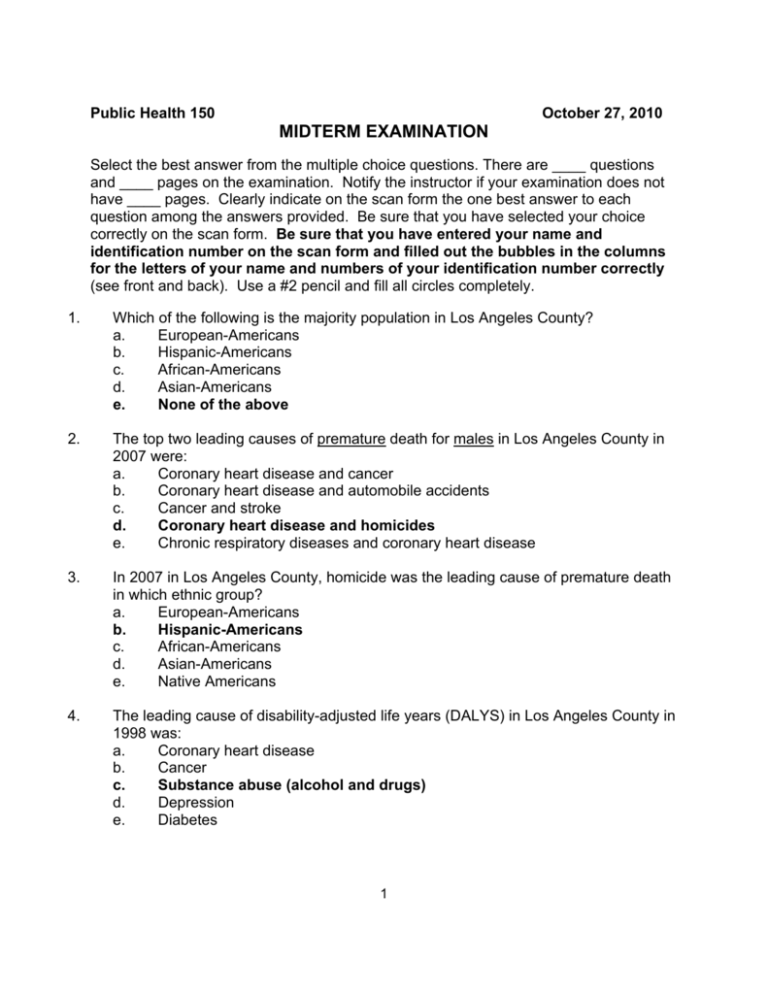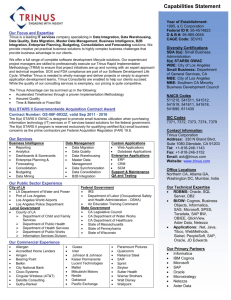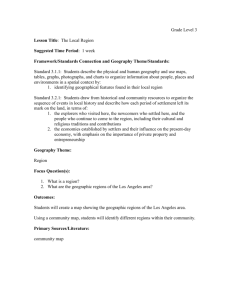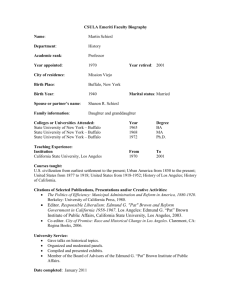MIDTERM EXAMINATION - UCLA School of Public Health
advertisement

Public Health 150 October 27, 2010 MIDTERM EXAMINATION Select the best answer from the multiple choice questions. There are ____ questions and ____ pages on the examination. Notify the instructor if your examination does not have ____ pages. Clearly indicate on the scan form the one best answer to each question among the answers provided. Be sure that you have selected your choice correctly on the scan form. Be sure that you have entered your name and identification number on the scan form and filled out the bubbles in the columns for the letters of your name and numbers of your identification number correctly (see front and back). Use a #2 pencil and fill all circles completely. 1. Which of the following is the majority population in Los Angeles County? a. European-Americans b. Hispanic-Americans c. African-Americans d. Asian-Americans e. None of the above 2. The top two leading causes of premature death for males in Los Angeles County in 2007 were: a. Coronary heart disease and cancer b. Coronary heart disease and automobile accidents c. Cancer and stroke d. Coronary heart disease and homicides e. Chronic respiratory diseases and coronary heart disease 3. In 2007 in Los Angeles County, homicide was the leading cause of premature death in which ethnic group? a. European-Americans b. Hispanic-Americans c. African-Americans d. Asian-Americans e. Native Americans 4. The leading cause of disability-adjusted life years (DALYS) in Los Angeles County in 1998 was: a. Coronary heart disease b. Cancer c. Substance abuse (alcohol and drugs) d. Depression e. Diabetes 1 5. The majority of tuberculosis cases in Los Angeles County are in: a. Hispanics b. Asians c. Migrants from Asia and Latin America d. Migrants from Eastern Europe e. Native Americans 6. There is currently an epidemic of syphilis among which group in Los Angeles County? a. European-Americans b. Hispanic-Americans c. African-Americans d. Asian-Americans e. Men who have sex with men 7. Rates of coronary heart disease, stroke, lung cancer, emphysema and pneumonia in Los Angeles County are: a. Declining b. Increasing c. Remaining stable 8. The incidence rate of which of the following leading causes of death in LA County increased dramatically rather than decreased 1998-2007? a. Coronary heart disease b. Stroke c. Alzheimer’s disease d. HIV/AIDS e. All of above 9. More than half of the population in LA County was physically active (met guidelines) in 2007: a. True b. False 10. The leading behavioral cause of death in the United States in 2000 was: a. Tobacco b. Unhealthy diet c. Substance abuse d. Motor vehicle accidents e. Firearms 11. Major preventable risk factors for disease in the United States include a. Unhealthy diet and physical inactivity b. Environmental and occupational hazards c. Smoking and substance abuse d. All of the above e. a. and c. above 2 12. The Centers for Disease Control and Prevention (CDC) estimates up to 80% of type 2 diabetes, 40% of cancer, and 80% of heart disease and stroke in the U.S. could be prevented, if Americans were to do three things, which are: a. Stop smoking, reduce alcohol consumption, use protection during sexual activity b. Eat healthy, use protection during sexual activity, reduce stress c. Stop use of illicit drugs, reduce alcohol consumption, eat healthy d. Stop smoking, eat healthy, exercise regularly e. None of above 13. There are large disparities in life expectancy among race/ethnicity groups in LA County. Which of the following ethnic groups had the longest life expectancy in LA County in 2008? a. Caucasian b. Latino c. African-American d. Asian and Pacific Islander e. None of above 14. Smoking rates are highest in which ethnic group in the United States? a. Caucasian b. Hispanic-American c. African-American d. Asian-American 15. There is a downward trend in obesity among Los Angeles County school children: a. True b. False 16. The percentage of the population of Los Angeles living in poverty is: a. Increasing b. Decreasing c. Remaining stable 17. The percentage of schools with fast food restaurants nearby is highest in: a. The highest high income neighborhoods b. Middle income neighborhoods c. The lowest income neighborhoods d. About equal in all neighborhoods. 18. Chain restaurants are now required to post menu labeling for calories. a. True b. False 3 19. The “bible” of mental health is: a. The Physicians’ Desk Reference b. The website of the American Mental Health Association c. The Diagnostic and Statistical Manual IV-R (DSM IV) d. The Drug Detail person e. None of the above 20. The essential factor in the diagnosis of a mental disorder is: a. The inability to do what that person usually does b. A conflict between the individual and society c. Culturally sanctioned responses to events d. The co-occurrence of multiple symptoms 21. The diagnosis of a mental disorder depends in part on the cultural norms of the individual’s society: a. True b. False 22. The single most prevalent mental disorder in the United States is: a. Schizophrenia b. Manic/depressive disorder c. Substance disorders d. Depression e. b. and c. above 23. To be diagnosed as having a depressive episode, the individual must have depressed mood plus at least ______ additional symptom(s). a. one b. two c. four d. six 24. A depression episode is predictive of having additional depression episodes in the future: a. True b. False 25. According to the results from National Epidemiologic Survey on Alcohol and Related Conditions (NESARC) study, which of the following ethnic groups has shown the highest 12-month prevalence of any mood disorder? a. Caucasian b. African-American c. Native American d. Asian-American e. Hispanic 4 26. Which of the following is thought to be the most severe mental disorder? a. Bipolar disorder b. Dementia c. Drug dependence d. Schizophrenia e. None of above 27. The most common substance disorder among females in the United States is: a. Alcohol abuse b. Alcohol dependence c. Drug abuse d. Drug dependence 28. The lifetime prevalence of a psychiatric disorder in the U.S. is: a. 10% b. 25% c. 50% d. 75% e. 90% 29. The low rate of mental disorders among ethnic minority groups in the U.S. may be explained by: a. Coping practices; e.g. religiosity b. Artifactual factors in ascertainment of mental disorders c. Sociodemographic characteristics d. Cultural factors e. All of the above 30. The social causes of mental disorders include: a. Low socio-economic status b. Excessive exposure to stressful life circumstances c. Lack of compensatory and coping resources d. All of the above e. a. and c. above 31. According to Detels (2003), the goal of public health is to assure the “biologic, physical, and ______________ well being of all members of the global society.” a. social b. mental c. environmental d. economic e. None of above 32. Policy change is beyond the scope of public health: a. True b. False 5 33. “Health” is a state of equilibrium between: a. Time, place and person b. Time, agent and environment c. Agent, host and environment d. Host, agent and place e. None of above 34. Epidemiology is a methodology of studying a health problem; it is not a body of knowledge: a. True b. False 35. Which of the following is/are incidence rate(s)? a. Number of newly detected HIV infections in LA County during September, 2010 divided by the population at risk of HIV infection at the same time b. Number of lung cancer cases in the US at the beginning of 2010 divided by the total population in the U.S. at the same time c. Number of diabetes cases in New York City in July 1, 2010 divided by the population of New York City at the same time d. a. and c. above e. b. and c. above 36. Epidemiologists describe disease/states in terms of time, place, and person: a. True b. False 37. On the calendar of September, 2013 below, Dr. Chang marks each new case of “X disease” with an “X” on its date of occurrence. Which of the diseases below is most likely to be “X disease”? 1 2 3 4 5 8 9 10 11 12 6 7 13 14 XXXXX XXXXX XX 15 16 XXXXXXX XXXX 22 23 29 30 XXXXXXXXX XXXXXXXXXX a. b. c. d. e. 17 18 19 20 21 24 25 26 27 28 XXXX XXXXXXX XXXXXXXXX XXXXXXXXXX XXXXXXXXXX Colorectal cancer Measles Food poisoning AIDS None more likely than the others 6 38. Which of the following is/are the use(s) of epidemiology in public health? a. Community diagnosis b. Establishing the history of a disease c. Estimating risks d. a., b., and c. above e. b. and c. above 39. Biostatistics can be used to accurately predict rare adverse outcomes of a new pharmaceutical drug: a. True b. False 40. Statisticians and epidemiologists do which of the following with population data? a. Gather b. Analyze c. Interpret d. All of the above 41. In regression analysis, Y represents _________ and X represents ____________: a. Treatment - outcome b. Outcome - treatment/covariates c. Treatment/covariates - outcome d. None of the above 42. A major ethical concern with DNA microarrays is: a. Potential for discrimination b. Profiling health insurance eligibility c. a. and b. above d. None of the above 43. In the past, infectious diseases have caused more deaths in wars than casualties of the armed conflicts: a. True b. False 44. The leading infectious disease killer globally is: a. Tuberculosis b. Diarrhea c. Malaria d. AIDS e. Acute respiratory infections 45. Emergence of new infectious disease is caused by: a. Genetic factors b. Behavioral factors c. Climate change d. All of the above e. None of above 7 46. Death from infectious disease is disproportionately higher in people under 5 years of age: a. True b. False 47. The majority of deaths attributable to ____________________ diseases occur in ____________________ income countries. a. Noncommunicable - low and middle b. Noncommunicable - high c. Cardiovascular - high d. Communicable - high 48. Emerging infectious diseases are: a. Newly identified agents b. Mutations of zoonotic agents that cause human disease c. Resurgence of drug resistant forms of disease d. All of the above e. None of above 49. Which of the following is/are an example of re-emerging infectious disease? a. Smallpox b. Malaria c. Tuberculosis d. All of the above e. b. and c. above 50. Antigenic drift is the result of errors in _______________ and lack of a repair mechanism to correct errors. Antigenic shift is the _______________ of genetic materials when concurrent infection of different _______________ occurs in the same host. a. replication - reassortment - strains b. deletion - incubation - pathogens c. reassortment - replication - strains d. incubation - deletions - pathogens e. None of above 51. The role of the public health professional is to: a. Educate the public about ways to attain maximum health b. Alert the public to current health problems c. Anticipate future health problems d. All of the above e. a. and b. above 52. To avoid getting the flu you should: a. Wash hands with soap and water or alcohol frequently b. Avoid contact with sick people c. Avoid crowded environments like PH150 lectures d. All of the above e. a. and b. above 8 53. In the U.S, large companies (over 200 workers): a. Are more likely to offer health insurance to their employees than smaller companies b. Almost all (>95%) offer health insurance to employees. c. Because of pressure from shareholders, are less likely to offer health insurance to employees than smaller firms d. a. and b. above 54. Which of the following age groups has the largest number of uninsured? a. 0-18 years b. 19-24 years c. 25-34 years d. 35-44 years e. 45-54 years 55. In his presentation, Dr. Kominski referred to the “80/20 rule.” He used this to describe the fact that in the U.S. that: a. 20% of the population account for 80% of health care spending b. 80% of health insurance is provided by 20% of U.S. business firms c. For every 80 insured Americans, there are 20 uninsured Americans d. The health care costs for people 80 years old cost 4 times that of 20-yearolds e. None of the above 56. With reference to Medicare, the “doughnut hole,” refers to the fact that, until recent legislation, Medicare enrollees have had to: a. Pay for the first 25% of all health care costs out of pocket. b. Have a life-saver clause that pays expenses if they exceed about $3000. c. Pay 100% for prescription drugs in the middle range of expenditures (between about $2800 to $6500) d. Follow a low-calorie diet or their benefits are decreased e. None of the above. 57. Recent federal legislation will provide insurance relief by: a. Subsidizing health insurance for lower income families b. Eliminating pre-existing conditions exclusions c. Protecting those who lose employment-based insurance d. Allowing children to remain on parents’ policies till the child is 26 e. All of the above 58. One of the major reasons for the increasingly high cost of healthcare in the US is increasing numbers of: a. Illegal immigrants b. New medical technologies c. Uninsured 20-30 year olds d. Welfare recipients e. None of above 9 59. In the U.S., Medicare is an example of private insurance. a. True b. False 60. The correlation between GDP per capita and life expectancy at birth: a. Proves that wealth improves health and prevents disease b. Shows that economic output is improved by worker longevity c. Means spending on healthcare leads to better health d. Implies a common cause e. None of above 61. In the U.S., health disparities are exemplified by: a. Higher incidence of breast cancer seen in American women b. Higher incidence of sickle-cell disease seen in African-Americans c. Shorter life expectancy seen in African-American men d. All of the above e. None of above 62. The majority of national health expenditures in the U.S. go to: a. Nursing home care b. Prescription drugs c. Hospital care d. Research and public health activities e. None of above 10








